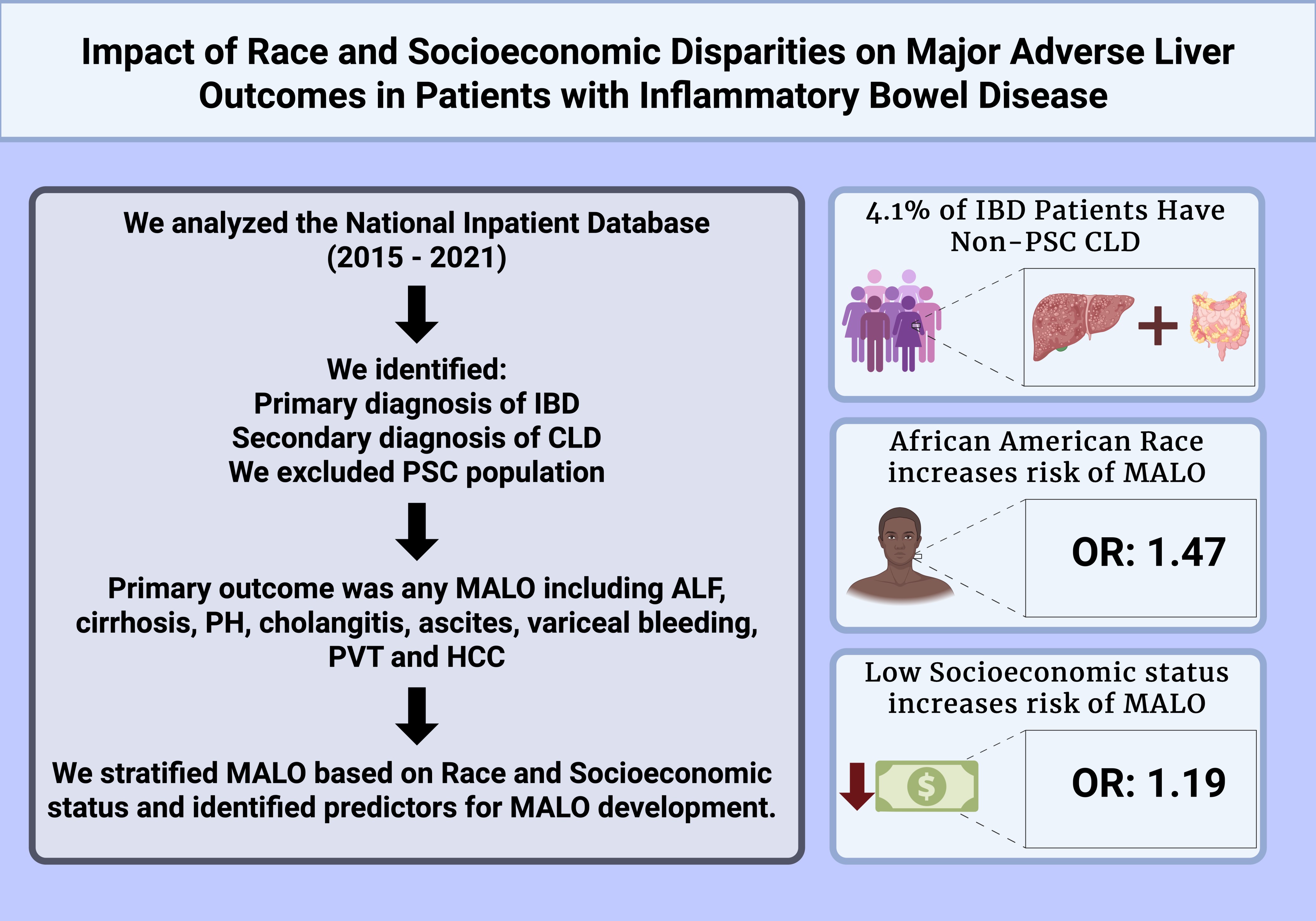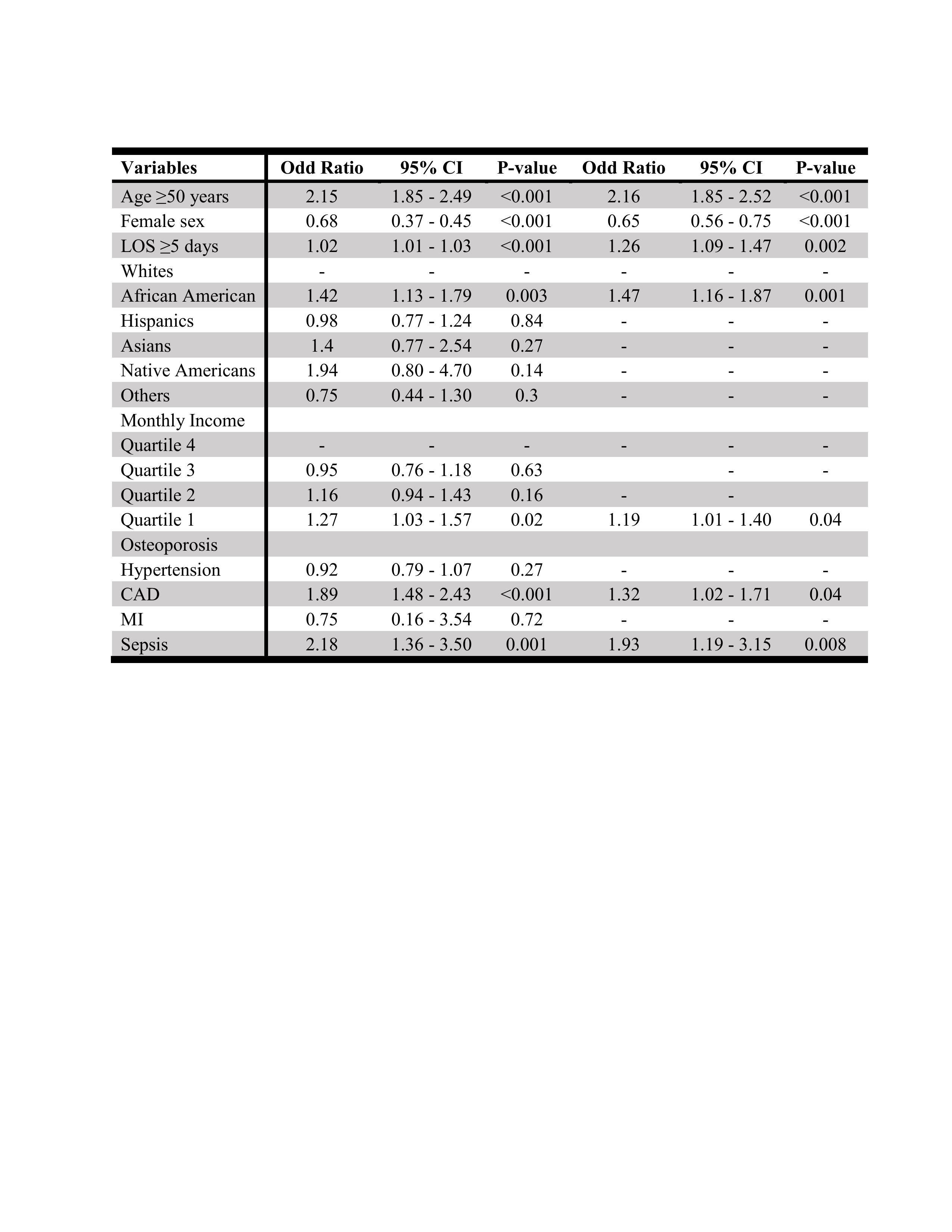Tuesday Poster Session
Category: IBD
P5485 - Impact of Race and Socioeconomic Disparities on Major Liver Adverse Events in Patients With Inflammatory Bowel Disease: A Study Using the National Inpatient Sample
Tuesday, October 28, 2025
10:30 AM - 4:00 PM PDT
Location: Exhibit Hall

Kelly M. Vo, DO (she/her/hers)
Walter Reed National Military Medical Center
Bethesda, MD
Presenting Author(s)
Kelly M. Vo, DO1, Leandro Sierra, MD2, Karimar Amador-Martinez, MD3, Nikki Duong, MD3
1Walter Reed National Military Medical Center, Bethesda, MD; 2Department of Internal Medicine, Cleveland Clinic, Cleveland, OH; 3Stanford University, Stanford, CA
Introduction: Inflammatory bowel disease (IBD) is associated with worse outcomes in patients with chronic liver disease (CLD). However, it remains unclear which specific complications constitute major adverse liver outcomes (MALO) and to what extent racial and socioeconomic disparities contribute to these outcomes. The aim of our study is to identify MALO in patients with both IBD and CLD, while evaluating the influence of race and socioeconomic status.
Methods: This retrospective cohort study analyzed hospitalized adults with IBD and CLD using the National Inpatient Sample database (2015–2021). Demographic variables included age, sex, and race/ethnicity. Socioeconomic status included household income. Clinical variables included length of hospital stay, in-hospital mortality, and the presence of common comorbidities.
Results: Among 97,628 hospitalized adult IBD patients, 4.11% had secondary CLD. Majority of IBD-CLD were White (74.94%) and from lower-income households (53.83% had income < $35,000). Racial disparities were evident, with significant differences in comorbidities such as sepsis, cholangitis, and hepatocellular carcinoma. Depression (20.18%) and anxiety (24.21%) were prevalent, especially among White patients. Multivariable regression analysis demonstrated that African Americans had higher odds of MALO compared to Whites (OR 1.42, p=0.003). Additionally, lowest socioeconomic status (OR 1.19, p=0.04), older age (≥50 years; OR 2.15, p< 0.001), and extended hospital stay (≥5 days; OR 1.26, p=0.002) were independently associated with increased MALO. Female sex was associated with reduced odds of MALO (OR 0.68, p< 0.001) (Table 1).
Discussion: Older age, prolonged hospitalization, African American race, and lower socioeconomic status significantly increase odds of MALO in IBD patients with CLD. Interventions reducing health inequities are desperately needed to mitigate disparities amongst this patient population.

Figure: Graphical Abstract;
Abbreviations: IBD (inflammatory bowel disease), CLD (chronic liver disease), PSC (primary sclerosing cholangitis), MALO (major adverse liver outcomes), ALF (acute liver failure), PH (portal hypertension), PVT (port vein thrombosis), HCC (hepatocellular carcinoma)

Figure: Table 1: Odds of Major Liver Events among Patients with Chronic Liver Disease and Inflammatory Bowel Disease;
Abbreviations: confidence interval (CI), length of stay (LOS), coronary artery disease (CAD), myocardial infarction (MI);
Note: The monthly income quartiles were derived from 1999 demographic data and classified as follows: Quartile 1 ($1–$24,999), Quartile 2 ($25,000–$34,999), Quartile 3 ($35,000–$44,999), and Quartile 4 ($45,000 or more).
Disclosures:
Kelly Vo indicated no relevant financial relationships.
Leandro Sierra indicated no relevant financial relationships.
Karimar Amador-Martinez indicated no relevant financial relationships.
Nikki Duong indicated no relevant financial relationships.
Kelly M. Vo, DO1, Leandro Sierra, MD2, Karimar Amador-Martinez, MD3, Nikki Duong, MD3. P5485 - Impact of Race and Socioeconomic Disparities on Major Liver Adverse Events in Patients With Inflammatory Bowel Disease: A Study Using the National Inpatient Sample, ACG 2025 Annual Scientific Meeting Abstracts. Phoenix, AZ: American College of Gastroenterology.
1Walter Reed National Military Medical Center, Bethesda, MD; 2Department of Internal Medicine, Cleveland Clinic, Cleveland, OH; 3Stanford University, Stanford, CA
Introduction: Inflammatory bowel disease (IBD) is associated with worse outcomes in patients with chronic liver disease (CLD). However, it remains unclear which specific complications constitute major adverse liver outcomes (MALO) and to what extent racial and socioeconomic disparities contribute to these outcomes. The aim of our study is to identify MALO in patients with both IBD and CLD, while evaluating the influence of race and socioeconomic status.
Methods: This retrospective cohort study analyzed hospitalized adults with IBD and CLD using the National Inpatient Sample database (2015–2021). Demographic variables included age, sex, and race/ethnicity. Socioeconomic status included household income. Clinical variables included length of hospital stay, in-hospital mortality, and the presence of common comorbidities.
Results: Among 97,628 hospitalized adult IBD patients, 4.11% had secondary CLD. Majority of IBD-CLD were White (74.94%) and from lower-income households (53.83% had income < $35,000). Racial disparities were evident, with significant differences in comorbidities such as sepsis, cholangitis, and hepatocellular carcinoma. Depression (20.18%) and anxiety (24.21%) were prevalent, especially among White patients. Multivariable regression analysis demonstrated that African Americans had higher odds of MALO compared to Whites (OR 1.42, p=0.003). Additionally, lowest socioeconomic status (OR 1.19, p=0.04), older age (≥50 years; OR 2.15, p< 0.001), and extended hospital stay (≥5 days; OR 1.26, p=0.002) were independently associated with increased MALO. Female sex was associated with reduced odds of MALO (OR 0.68, p< 0.001) (Table 1).
Discussion: Older age, prolonged hospitalization, African American race, and lower socioeconomic status significantly increase odds of MALO in IBD patients with CLD. Interventions reducing health inequities are desperately needed to mitigate disparities amongst this patient population.

Figure: Graphical Abstract;
Abbreviations: IBD (inflammatory bowel disease), CLD (chronic liver disease), PSC (primary sclerosing cholangitis), MALO (major adverse liver outcomes), ALF (acute liver failure), PH (portal hypertension), PVT (port vein thrombosis), HCC (hepatocellular carcinoma)

Figure: Table 1: Odds of Major Liver Events among Patients with Chronic Liver Disease and Inflammatory Bowel Disease;
Abbreviations: confidence interval (CI), length of stay (LOS), coronary artery disease (CAD), myocardial infarction (MI);
Note: The monthly income quartiles were derived from 1999 demographic data and classified as follows: Quartile 1 ($1–$24,999), Quartile 2 ($25,000–$34,999), Quartile 3 ($35,000–$44,999), and Quartile 4 ($45,000 or more).
Disclosures:
Kelly Vo indicated no relevant financial relationships.
Leandro Sierra indicated no relevant financial relationships.
Karimar Amador-Martinez indicated no relevant financial relationships.
Nikki Duong indicated no relevant financial relationships.
Kelly M. Vo, DO1, Leandro Sierra, MD2, Karimar Amador-Martinez, MD3, Nikki Duong, MD3. P5485 - Impact of Race and Socioeconomic Disparities on Major Liver Adverse Events in Patients With Inflammatory Bowel Disease: A Study Using the National Inpatient Sample, ACG 2025 Annual Scientific Meeting Abstracts. Phoenix, AZ: American College of Gastroenterology.
